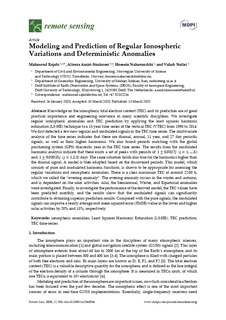| dc.description.abstract | Knowledge on the ionospheric total electron content (TEC) and its prediction are of great practical importance and engineering relevance in many scientific disciplines. We investigate regular ionospheric anomalies and TEC prediction by applying the least squares harmonic estimation (LS-HE) technique to a 15 year time series of the vertical TEC (VTEC) from 1998 to 2014. We first detected a few new regular and modulated signals in the TEC time series. The multivariate analysis of the time series indicates that there are diurnal, annual, 11 year, and 27 day periodic signals, as well as their higher harmonics. We also found periods matching with the global positioning system (GPS) draconitic year in the TEC time series. The results from the modulated harmonic analysis indicate that there exists a set of peaks with periods of 1±0.0027j ( j=1,…,5 ) and 1±0.00025j ( j=1,2,3 ) days. The same situation holds also true for the harmonics higher than the diurnal signal. A model is then adopted based on the discovered periods. This model, which consists of pure and modulated harmonic functions, is shown to be appropriate for assessing the regular variations and ionospheric anomalies. There is a clear maximum TEC at around 22:00 h, which we called the “evening anomaly”. The evening anomaly occurs in the winter and autumn, and is dependent on the solar activities. Also, the Semiannual, Winter, and Equatorial anomalies were investigated. Finally, to investigate the performance of the derived model, the TEC values have been predicted monthly, and the results show that the modulated signals can significantly contribute to obtaining superior prediction results. Compared with the pure signals, the modulated signals can improve a yearly average root mean squared error (RMSE) value in the lower and higher solar activities by 20% and 15%, respectively. | nb_NO |

